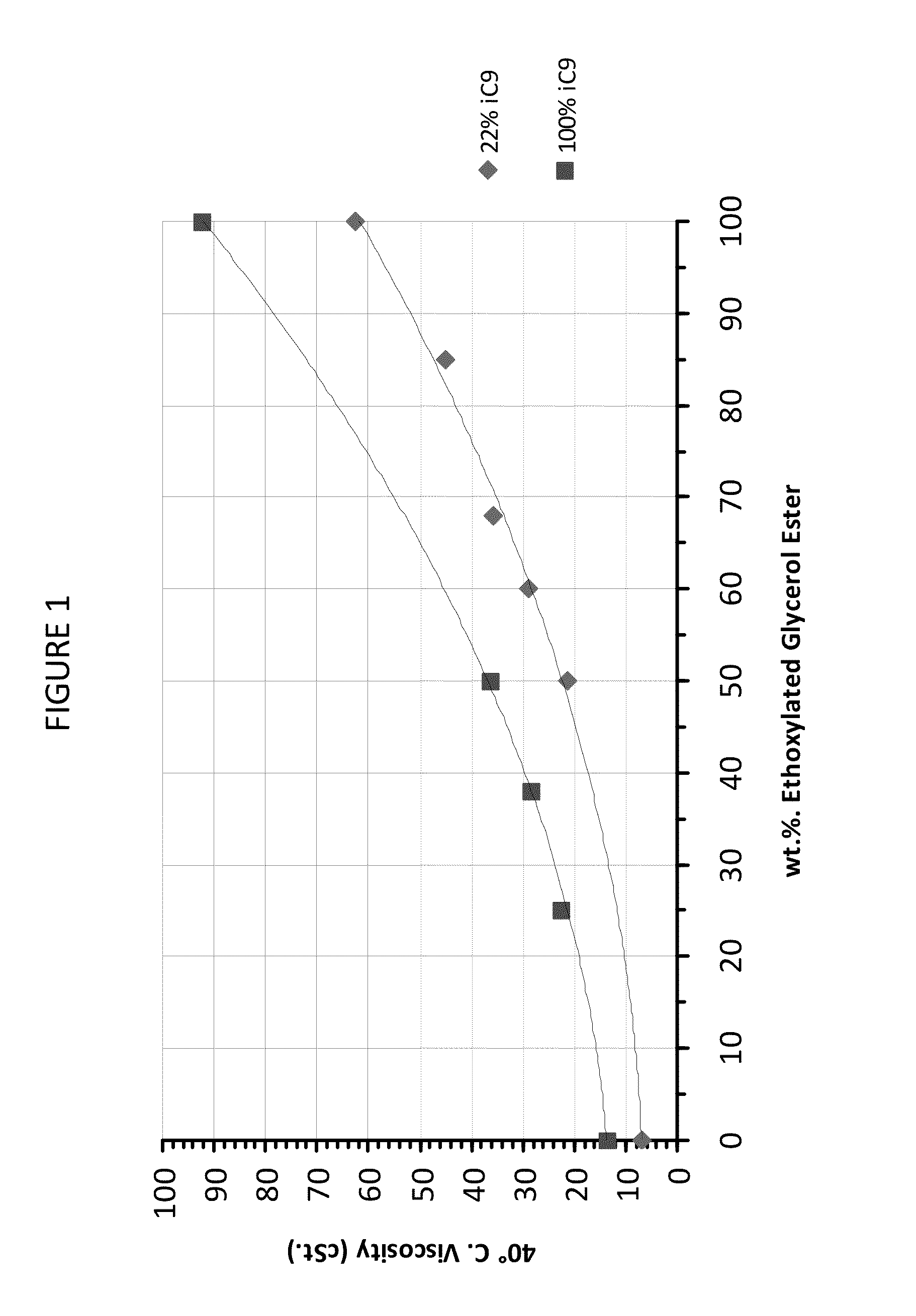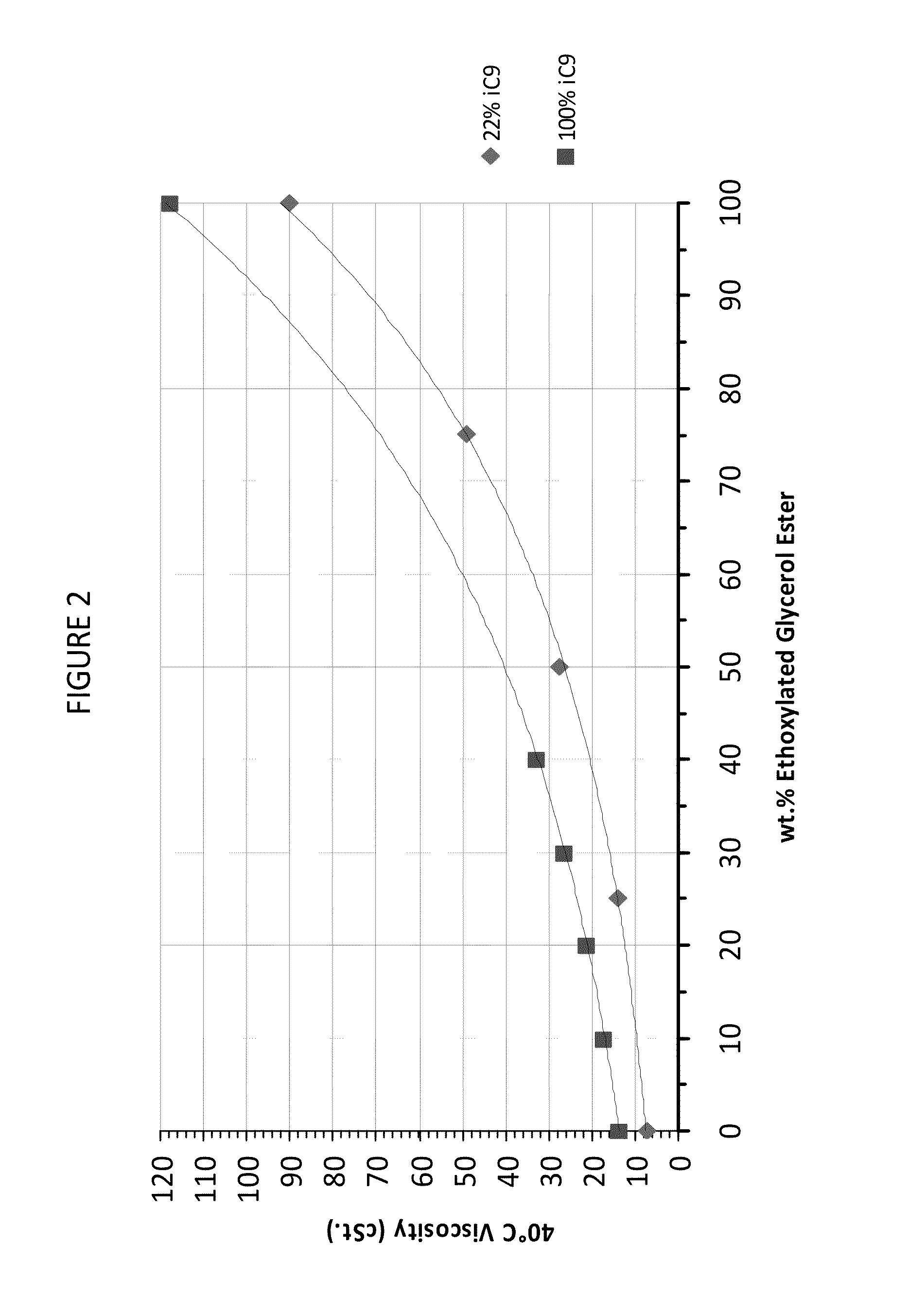Refrigeration compressor lubricant
a compressor and lubricant technology, applied in the field of lubricants, can solve the problems of affecting the reliability of compressors, insufficient lubricant circulation, etc., and achieve the effects of excellent viscosity indices and lubricities, and excellent miscibility
- Summary
- Abstract
- Description
- Claims
- Application Information
AI Technical Summary
Benefits of technology
Problems solved by technology
Method used
Image
Examples
examples
[0070]In the following examples, properties are determined by the following methods.
[0071]Kinematic viscosity is measured according to ASTM D445.
[0072]Lubricity is measured according to ASTM D2670.
[0073]Viscosity index is determined according to ASTM D2270.
[0074]The miscibility temperature range of a lubricant composition in a refrigerant is determined as follows: The lubricant composition (20% by weight) and the refrigerant (80% by weight) are added gravimetrically to a heavy-walled glass test tube. The tube is then sealed. The mixture of lubricant and refrigerant in the sealed tube is visually observed while being cooled (generally to no lower than −40° C.) and warmed (generally to no higher than 78° C.). The temperature at which phase separation is visually observed was designated as the limit of miscibility. The maximum miscibility temperature is the highest temperature before phase separation is observed; the minimum miscibility temperature is the lowest temperature before phas...
examples 1-11
Lubricants According to the Inventive Technology
[0092]The 78% linear esters of Preparation A and Preparation C were combined in the weight ratios indicated in Examples 1 through 8 and tested for the properties shown. In a like manner the 100% branched esters of Preparation D and Preparation C were combined in the weight ratios indicated in Examples 9 through 11 and tested for the properties shown.
TABLE 1PropertiesLubricant composition, % by weightKinematicPreparationPreparationPreparationPreparationViscosity (cSt)ViscosityMiscibility inMiscibility inExampleABDCat 40° C. / 100° C.IndexR410a (° C.)R32 (° C.)Example 1—100 ——6.97 / 2.2815472 to −70*Example 23070——39 to −70*56 to −40*Example 34060——41 to −70*Example 45050——21.3 / 5.4821418** to −57*Example 56040—— 29 / 6.820432 to −6025 to −60Example 66832——35.6 / 7.4018118** to −57*Example 78515——45.0 / 9.79211Example 8100 ———62.6 / 12.7208−7.8 to −57*Example 9———100 13.4 / 3.4614172 to −70*Example 10——257522.2 / 5.0816756 to −40*Example 11——307039 to −7...
example 12
One-Pot Preparation of a Lubricant According to the Inventive Technology: Combination of 25 Weight % Glycerol Ethoxylate Ester (Glycerol Ethoxylate Mn˜1000) and 75 Weight % Tetraethylene Glycol Ester of 3,3,5-Trimethylhexanoic Acid (No Solvent)
[0101]To a 2-liter reactor equipped with a mechanical stirrer, water trap, nitrogen source, thermocouple, and reflux condenser were added at once 176 grams of glycerol ethoxylate (Mn˜1000), 307 grams of tetraethylene glycol, and 611 grams of 3,3,5-trimethylhexanoic acid. This addition was followed by an addition of 0.25 gram of tin(II) oxylate. The mixture was stirred under a nitrogen blanket and slowly heated to 230° C. The temperature was maintained at 230° C. for about 6.5 hours. During the heating period, the water of reaction was collected in the water trap and any carboxylic acid distilled was returned to the reactor. At the end of the reaction (as measured by the water collected), the excess carboxylic acid was distilled, collected, and...
PUM
| Property | Measurement | Unit |
|---|---|---|
| miscibility temperature | aaaaa | aaaaa |
| weight percent | aaaaa | aaaaa |
| temperatures | aaaaa | aaaaa |
Abstract
Description
Claims
Application Information
 Login to View More
Login to View More - R&D
- Intellectual Property
- Life Sciences
- Materials
- Tech Scout
- Unparalleled Data Quality
- Higher Quality Content
- 60% Fewer Hallucinations
Browse by: Latest US Patents, China's latest patents, Technical Efficacy Thesaurus, Application Domain, Technology Topic, Popular Technical Reports.
© 2025 PatSnap. All rights reserved.Legal|Privacy policy|Modern Slavery Act Transparency Statement|Sitemap|About US| Contact US: help@patsnap.com



